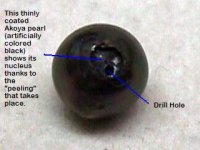Natural is always better. You will find a lot of natural, light pinks in freshwater pearls, but rarely in Akoya. A problem with the Akoya is it can be very difficult to detect the pinking at times, with freshwater pearls it is a lot easier. If the pearls are deep pink, you can be nearly sure that they have been dyed.
The silver color can be obtained using silver dye. This color may, however, be natural in Akoya. A lot of harvested Akoya pearls are quite grey in color, straight out of the oyster that is. I would say at least 20% of any given harvest has this coloration. These pearls are typically dyed black if they cannot be bleached white, but the very nice ones are typically kept for sale. I have seen natural grey pearls (Akoya) that were not treated only to sell at local markets at low prices (for local Chinese). The quality was sub par, but the farmer was selling the strands for $1-$3 each. Barely covering his cost of the nucleus...

